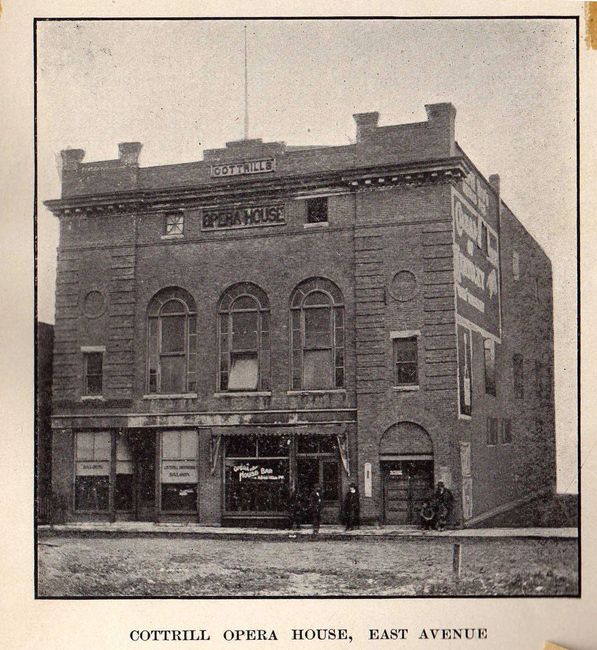
Out on the Town
Social Life and Entertainment
Thomas residents enjoyed a variety of entertainment and social activities. The town had many musicians, including Patsy Santangelo, a gifted trumpet player and owner of a shoe repair shop (Tour No. 40). Patsy taught music lessons to many young people and his son Ralph became a professional musician in Los Angeles. The Thomas town band and a number of jazz ensembles played the local Imperial Hotel, dances and other venues. The Roma Restaurant (No. 39), with its upstairs dance hall, and the Varsity (No. 2), which had the first jukebox in town, were favorite local hangouts for people of all ages. Historic photos of these spots evoke images of the classic soda fountain, authentic diner food, friendly conversation and neatly-dressed waitresses.
Thomas also offered alternative opportunities for letting loose, described in some historical accounts as “boozing, carousing and rowdyism.” In 1912 alone, eight saloon licenses in the town were approved by the County Court. Several generations of the Thayer family operated a saloon in their building (No. 37) almost from the day Phoebe Thayer purchased the lot from the Davis Coal and Coke Company in 1893. This was in spite of the fact that the deed specifically prohibited the sale of alcohol on the property. The Sportman’s Club, run for many years by Phoebe’s grandson Stuart Thayer, was famous for its taxidermy collection, particularly a semi-hidden mounted rattlesnake that would startle the unsuspecting newcomer.
Cottrill's Opera House
Hiram B. Cottrill, born in Harrison County in 1865, came to Thomas in 1887 to work for the Davis Coal and Coke Company. He left the coal business to start a saloon, but many of his buildings were destroyed in the 1901 fire. His Opera House (Tour No. 1) became a center of entertainment and culture not only for Thomas, but for many neighboring towns. Despite its name, the Opera House featured primarily vaudeville shows and movies, and had an “elegant saloon” on its first floor. The Sutton family bought the theater in 1917 and operated it into the 1970s.
The Opera House is the most recognizable building in Thomas and is inspired by Italian Renaissance palazzi (palaces). The three-story brick structure is defined by three grand arched windows. The outer left and right bays, which extend all the way through the parapet wall, anchor the building and are marked by brick pilasters. The second-floor theatre level is reached through the arched opening at right. (Image Source: Thomas, WV 1906 by T. Nutter, Courtesy Miners and Merchants Bank)
Thomas was home to a variety of musical groups, including the official Thomas Concert Band. (Courtesy Russell L. Cooper).

Seen here, left to right, are Tour Nos. 38, 39, 40, the predecessor to 41, and 1 (Cottrill’s Opera House). No. 39, a simple two-story commercial structure with brick corbel details, held the Roma Restaurant and dance hall, which was the place for fun and socialization for many years. Almost every building on the north end of East Avenue contained some sort of entertainment venue, saloon, dance hall or restaurant. (Courtesy Joseph Sagace)

On the other end of the architectural spectrum from the Opera House is the Thayer Building (Tour No. 37.), a wooden commercial structure with formal mass and symmetry but little ornament. Yet this building also had significant influence on social life and entertainment in its own way. Thayer descendents recall stories of vaudeville performers checking in to the boarding house and telling their children to sit on their travel trunks in the vestibule in order to guard them. And of course, decades have not changed the fact that a good drink at the corner bar is the preferred form of socializing for many. (Source: Thomas, WV 1906 by T. Nutter, Courtesy Miners and Merchants Bank)

In addition to running a shoe repair business for many years, Patsy Santangelo (Tour No. 40) was a talented trumpet player. Patsy operated his shop in the ground floor storefront of his brick commercial structure and lived on the floors above. People recall the sounds of his disciplined trumpet practice flowing onto East Avenue.
(Courtesy Joseph Sagace)
Patsy’s son Ralph also played the trumpet and achieved a successful career in Los Angeles. (Courtesy S. Massi)
Download the Social Life and Entertainment Tour Sign
Social (pdf)
DownloadHistoric Thomas West Virginia Walking Tour
a Project of the Tucker County Historic Landmark Commission, West Virginia Department of Arts, Culture and History, Aurora Research Associates, LLC and Digital Relativity, Inc.
www.aurora-llc.com Digitalrelativity.com
Copyright © 2020 Historic Thomas West Virginia Walking Tour - All Rights Reserved.
Powered by GoDaddy Website Builder